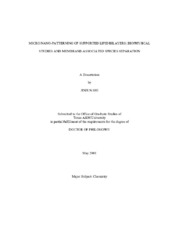| dc.description.abstract | Micro/nano-patterning of supported lipid bilayers (SLBs) has shown considerable potential for addressing fundamental biophysical questions about cell membrane behavior and the creation of a new generation of biosensors. Herein are presented several novel lithographic methods for the size-controlled patterning of SLBs from the microscale to the nanoscale. Using these methods, chemically distinct types of phospholipid bilayers and/or Escherichia Coli (E. Coli) membranes can be spatially addressed on a single microchip. These arrays can, in turn, be employed in the studies of multivalent ligand-receptor interactions, enzyme kinetics, SLBs size limitation, and membrane-associated species separation. The investigations performed in the Laboratory for Biological Surface Science include the following projects. Chapters II and III describe the creation of lab-on-a-chip based platforms by patterning SLBs in microfluidic devices, which were employed in high throughput binding assays for multivalent ligand-receptor interactions between cholera toxin B subunits (CTB) and ganglioside GM1. The studies on the effect of ligand density for multivalent CTB-GM1 interactions revealed that the CTB-GM1 binding weakened with increasing GM1 density. Such a result can be explained by the clustering of GM1 on the supported phospholipid membranes, which in turn inhibits the binding of CTB. Chapter IV characterizes the enzymatic activity of phosphatase tethered to SLBs in a microfluidic device. Higher turnover rate and catalytic efficiency were observed at low enzyme surface densities, ascribing to the low steric crowding hindrance and high enzyme fluidity, as well as the resulting improvement of substrate accessibility and affinity of enzyme catalytic sites. Chapter V presents sub-100 nm patterning of supported biomembranes by atomic force microscopy (AFM) based nanoshaving lithography. Stable SLBs formed by this method have a lower size limit of ~ 55 nm in width. This size limit stems from a balance between a favorable bilayer adhesion energy and an unfavorable bilayer edge energy. Finally, chapter VI demonstrates the electrophoretic separation of membrane-associated fluorophores in polymer-cushioned lipid bilayers. This electrophoretic method was applied to the separation of membrane proteins in E. Coli ghost membranes. | en |


